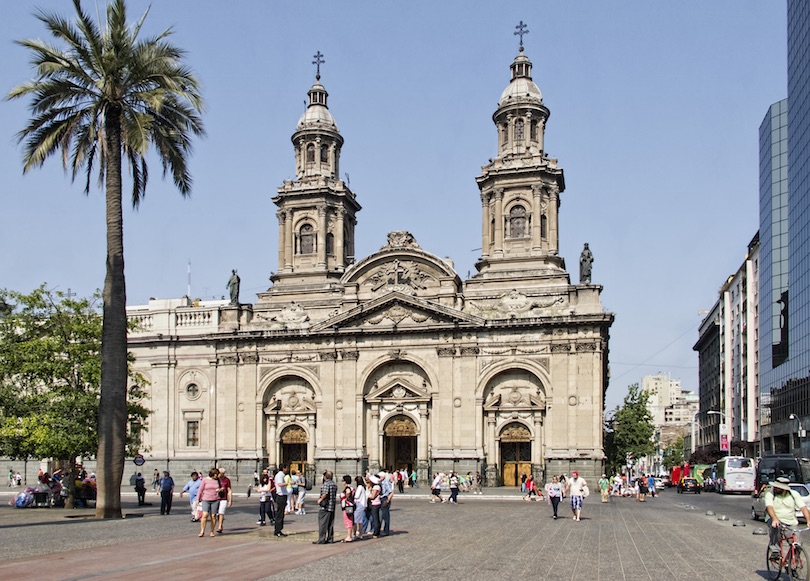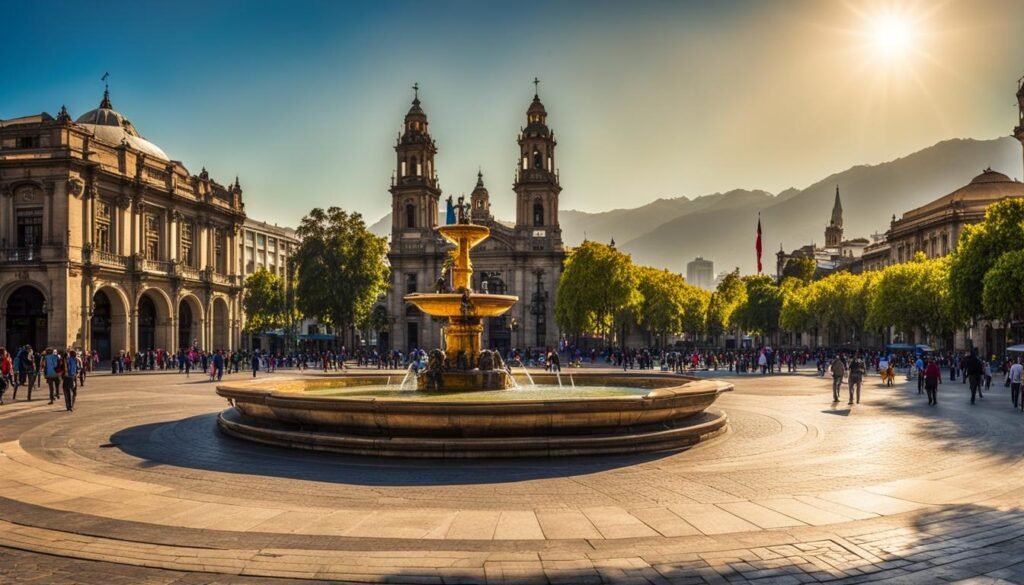
Santiago, Chile’s vibrant capital, is a city that dances to a unique rhythm, a captivating blend of soaring Andean peaks and bustling urban life. Nestled in a sprawling valley, it offers a rich tapestry of history, culture, gastronomy, and adventure, drawing travelers from across the globe. From its colonial roots to its modern-day cosmopolitan flair, Santiago is a city that surprises and delights at every turn. This comprehensive guide will delve into its top attractions, uncover its fascinating history, equip you with essential travel tips, explore accommodation options, navigate its transportation networks, and reveal the best times to experience its magic.
A Glimpse into Santiago’s Rich History: From Indigenous Roots to Modern Metropolis
The story of Santiago begins long before the arrival of Europeans. The valley was inhabited by the indigenous Picunche people, who lived in harmony with the fertile land. In 1541, Spanish conquistador Pedro de Valdivia founded Santiago del Nuevo Extremo, establishing it as the capital of the newly formed Spanish colony. The city’s early years were marked by resilience, enduring earthquakes and indigenous uprisings.

Related Articles about Santiago: A Symphony of Andes and Urbanity – Unveiling the Chilean Capital:
- Singapore City: A Jewel in the Lion City’s Crown – Your Ultimate Guide
- Discover Denmark: A Guide to Hygge, History, and Happening Adventures
- Vancouver: A Symphony of Nature and Urbanity – Your Ultimate Guide to the Emerald City
- Germany: A Tapestry of History, Culture, and Unforgettable Attractions
- Brazil: A Kaleidoscope of Wonders and the Stays That Define Them
Throughout the colonial era, Santiago grew as an administrative and religious center. The construction of its iconic Plaza de Armas, Cathedral, and other significant buildings laid the foundation for its architectural character. The 19th century brought the winds of independence, and Santiago played a pivotal role in Chile’s struggle against Spanish rule. Following independence, the city underwent significant modernization, with the construction of avenues, public parks, and the introduction of new technologies.
The 20th century saw Santiago evolve into a major South American metropolis. It experienced periods of political upheaval, including the democratic era, the military dictatorship, and the return to democracy. These events have left an indelible mark on the city’s psyche and its physical landscape. Today, Santiago stands as a testament to its enduring spirit, a dynamic city that embraces its past while boldly striding into the future.
Top Attractions: A Kaleidoscope of Experiences
Santiago offers a diverse array of attractions to cater to every interest. Here are some of the must-visit gems:
1. Plaza de Armas: The historic heart of Santiago, this grand square is a living museum. Admire the majestic Metropolitan Cathedral, a stunning example of neoclassical architecture, and the Correo Central (Central Post Office), a beautiful colonial building. The Museo Histórico Nacional (National History Museum), housed in the former Royal Palace, offers a captivating journey through Chile’s past. The plaza is always abuzz with activity, from street performers to local vendors, making it the perfect spot to soak in the city’s atmosphere.
2. Cerro San Cristóbal: Offering panoramic views of the city and the majestic Andes, Cerro San Cristóbal is an absolute must. Take the funicular or hike to the summit to witness breathtaking vistas, especially at sunset. At the top, you’ll find the iconic Immaculate Conception statue, a serene chapel, and a tranquil rose garden. The park also houses a zoo and a swimming pool, making it a popular destination for families.
3. La Chascona: This whimsical house museum was once the Santiago residence of Nobel laureate poet Pablo Neruda. Designed by Neruda himself, it’s a labyrinth of rooms filled with his personal belongings, art, and literary treasures. The eccentric architecture and the stunning views from its terraces offer a glimpse into the poet’s vibrant personality and creative spirit.
4. Barrio Lastarria: A charming bohemian neighborhood, Barrio Lastarria is a haven for art lovers and foodies. Wander through its cobblestone streets lined with independent boutiques, art galleries, theaters, and cozy cafes. The Centro Cultural Gabriela Mistral (GAM) is a modern cultural complex hosting a variety of exhibitions, performances, and workshops. In the evenings, the neighborhood comes alive with its vibrant restaurant scene, offering everything from traditional Chilean fare to international cuisine.
5. Museo Chileno de Arte Precolombino (Chilean Museum of Pre-Columbian Art): This world-class museum showcases an extraordinary collection of artifacts from indigenous cultures of the Americas, spanning thousands of years. From intricate pottery and textiles to ancient tools and ceremonial objects, it provides a profound insight into the rich artistic and cultural heritage of the region.

6. Mercado Central (Central Market): Immerse yourself in the vibrant chaos of Santiago’s main fish market. Beyond the impressive display of fresh seafood, you’ll find stalls selling local produce, spices, and traditional Chilean dishes. Enjoy a delicious seafood lunch at one of the market’s bustling restaurants, savoring the freshest catch of the day.
7. Bellavista Neighborhood: Known for its colorful houses, lively nightlife, and artistic vibe, Bellavista is another bohemian gem. Explore its narrow streets, discover quirky shops, enjoy street art, and experience the vibrant atmosphere of its bars and restaurants. It’s also home to La Chascona.
8. Museo de la Moda (Museum of Fashion): For those with an interest in style, this museum showcases a fascinating collection of clothing and accessories from various eras, offering a unique perspective on fashion history and its cultural significance.
9. Santiago Metropolitan Park (Parque Metropolitano): This vast urban park encompasses Cerro San Cristóbal and extends to other hills, offering a natural escape within the city. Besides the iconic summit, you can explore its diverse flora and fauna, botanical gardens, and enjoy various recreational activities.
10. Cajón del Maipo: A short drive from Santiago, this stunning mountain valley offers breathtaking natural beauty and outdoor adventure. Hike through dramatic landscapes, visit hot springs like Termas Valle de Colina, or embark on thrilling activities like rafting and horseback riding. It’s the perfect day trip for nature enthusiasts.
Travel Tips for a Seamless Santiago Experience
- Currency: The official currency is the Chilean Peso (CLP). Credit cards are widely accepted in most establishments, but it’s advisable to carry some cash for smaller purchases and markets.
- Language: Spanish is the official language. While English is spoken in tourist areas and larger hotels, learning a few basic Spanish phrases will greatly enhance your experience.
- Safety: Santiago is generally a safe city, but like any major metropolis, it’s important to be aware of your surroundings. Exercise caution in crowded areas, especially at night, and keep your valuables secure.
- Tipping: Tipping is customary in restaurants, bars, and for services like taxis and hotel staff. A 10% service charge is often included in restaurant bills, but an additional tip for good service is appreciated.
- Electricity: The voltage is 220V, and the frequency is 50Hz. Sockets are typically Type L. It’s advisable to bring an adapter if your devices use different plug types.
- Water: Tap water in Santiago is generally safe to drink, but many visitors prefer to drink bottled water to avoid any potential stomach upset.
- Altitude: Santiago is situated at a moderate altitude. While most people adjust easily, it’s advisable to stay hydrated and avoid strenuous activity on your first day.
- Sun Protection: The sun can be intense, especially during summer months. Always wear sunscreen, a hat, and sunglasses.
Accommodation Options: From Boutique Charm to Budget-Friendly Stays
Santiago offers a diverse range of accommodation to suit every budget and preference:
- Luxury Hotels: For a pampered experience, consider upscale hotels in areas like Providencia and Las Condes, offering world-class amenities, stunning city views, and impeccable service.
- Boutique Hotels: Explore the charming boutique hotels scattered throughout neighborhoods like Barrio Lastarria and Bellavista, offering unique character, personalized service, and a more intimate atmosphere.
- Mid-Range Hotels: You’ll find a good selection of comfortable and well-equipped mid-range hotels in various parts of the city, offering a good balance of comfort and affordability.
- Hostels: For budget travelers and backpackers, Santiago has a vibrant hostel scene, offering dormitory beds and private rooms in social and friendly environments, often in popular neighborhoods.
- Apartments and Airbnb: Renting an apartment or a room through Airbnb can be a great option for longer stays or for those seeking more independence and local living experience.
Navigating Santiago: Efficient Transportation Options
Santiago boasts a well-developed public transportation system, making it easy to get around:
- Metro: The Santiago Metro is one of the most efficient and modern subway systems in South America. It’s clean, safe, and covers most of the city’s major attractions and neighborhoods. Purchase a rechargeable Bip! card for easy travel.
- Buses: A vast network of buses complements the Metro, reaching areas not covered by the subway. However, they can be more crowded and navigating routes might be slightly more challenging for tourists.
- Taxis: Taxis are readily available throughout the city. It’s advisable to use official taxis or ride-sharing apps like Uber or Cabify, which are widely used and offer fixed prices.
- Ride-Sharing Apps: Uber and Cabify are very popular and convenient for getting around Santiago, especially for navigating to specific destinations or at odd hours.
- Walking: Many of Santiago’s central neighborhoods, such as Barrio Lastarria, Bellavista, and the historic center, are best explored on foot, allowing you to discover hidden gems and soak in the local atmosphere.
- Biking: Santiago is increasingly becoming a bike-friendly city, with dedicated bike lanes in many areas. Bike rental services are available, offering a healthy and enjoyable way to explore.
Best Time to Visit Santiago: Embracing the Seasons
Santiago experiences a Mediterranean climate with four distinct seasons, each offering a unique charm:
- Spring (September to November): This is a fantastic time to visit. The weather is pleasant, with mild temperatures and blooming flowers. It’s ideal for outdoor activities, exploring parks, and enjoying the city’s vibrant street life.
- Summer (December to February): Summers are hot and dry, with temperatures often exceeding 30°C (86°F). While it can be intense, it’s perfect for enjoying outdoor pools, visiting the coast (a day trip from Santiago), and experiencing the city’s lively summer festivals.
- Autumn (March to May): Autumn offers beautiful golden hues as the leaves change color, creating a picturesque setting. The weather is mild and comfortable, making it another excellent time to visit for sightseeing and outdoor exploration.
- Winter (June to August): Winters are cool and can be rainy, with temperatures averaging around 10°C (50°F). This is the season for skiing in the nearby Andes resorts. While the city itself might be less appealing for extensive outdoor activities, it offers a cozy atmosphere with fewer crowds and lower accommodation prices.
In conclusion, Santiago is a city that captivates with its diverse offerings. From the echoes of its rich history to the vibrant pulse of its modern urban life, it promises an unforgettable travel experience. Whether you’re drawn by its cultural treasures, its breathtaking natural surroundings, or its burgeoning culinary scene, Santiago stands ready to welcome you with open arms and a symphony of unforgettable moments.





